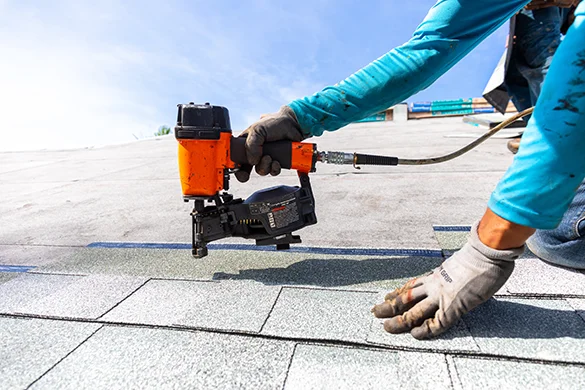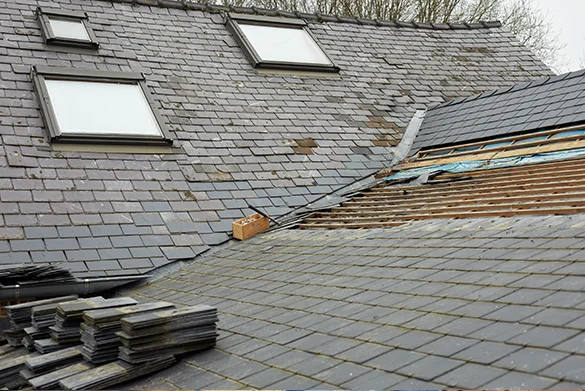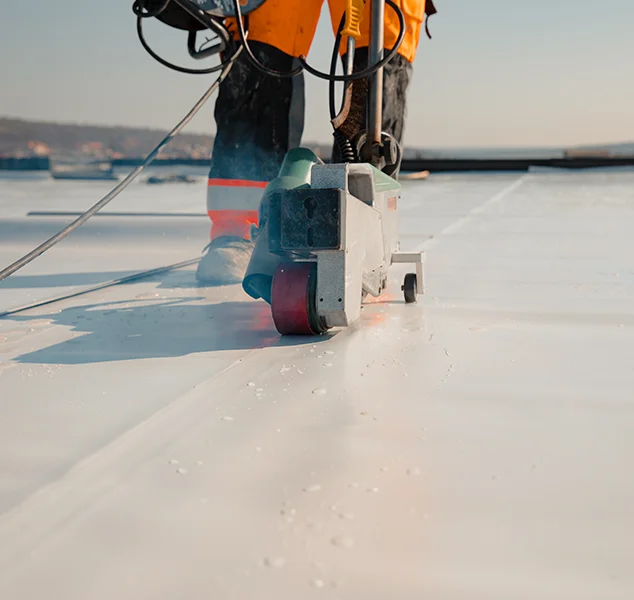House Siding Repair vs. Replacement: Deciding the Best Option for Your Home
When your home's siding shows damage, the critical question becomes whether siding house repair makes financial sense or if complete replacement provides better long-term value. This decision significantly impacts your budget, home protection, and property value. Making the wrong choice wastes money on repairs that only delay inevitable replacement, while premature replacement squanders siding that could have served effectively for years. This comprehensive guide helps Northern Virginia homeowners evaluate damage objectively and choose the most cost-effective path forward.
Assessing the Extent of Siding Damage
Start by conducting a thorough exterior inspection of all siding surfaces. Walk your home's perimeter during daylight hours, examining each wall section for visible damage. Common issues include cracked or broken panels, warping or buckling sections, faded or discolored areas, holes from impacts or pest damage, and loose or missing pieces. Document everything with photos noting specific locations and extent of each problem area.
Pay particular attention to moisture indicators. Water stains, mold growth, or soft spots when pressing siding panels suggest water intrusion behind the siding—a serious concern requiring immediate attention. Check inside your home for corresponding wall damage, particularly in areas where exterior siding shows problems. Interior moisture stains, peeling paint, or musty odors indicate siding failure allowing water penetration that threatens your home's structure.
The percentage of damaged siding matters significantly in repair-versus-replacement decisions. Isolated damage affecting less than 20% of total siding area typically justifies repair, especially if the damage concentrates in specific zones rather than spreading across multiple walls. Widespread damage exceeding 30-40% of surfaces often makes replacement more cost-effective than extensive piecemeal repairs. Similar assessment principles apply to roofing systems, as explained in our guide on shingle roof repair versus replacement decisions.

Age and Material Condition Drive the Decision
Siding age provides crucial context for repair-versus-replacement analysis. Vinyl siding typically lasts 20-40 years depending on quality and exposure conditions. If your Northern Virginia home's vinyl siding is 5-10 years old with localized damage, repair makes obvious sense. However, 25-year-old siding showing multiple problem areas likely approaches end of service life, making replacement the smarter investment even if current damage seems repairable.
Material condition beyond visible damage matters too. Vinyl siding becomes brittle over decades of UV exposure, making older panels prone to cracking during repair attempts. Fading and chalking indicate advanced weathering that compromises material integrity even in undamaged sections. Attempting repairs on deteriorated siding often causes additional breakage, turning simple repairs into expanding damage zones.
Wood siding ages differently than vinyl. Quality cedar or hardwood siding can last 50+ years with proper maintenance, but requires regular painting or staining. Extensive paint failure, rotted sections, or widespread woodpecker damage on 30-year-old wood siding might still justify repair if the underlying wood remains structurally sound. However, chronic moisture issues causing rot usually indicate systemic problems requiring complete siding replacement plus addressing underlying water management issues.
Repair Costs Versus Replacement Investment
Simple siding house repair costs typically range from $300-1,000 for replacing several damaged panels on a single wall section. More extensive repairs addressing multiple walls or complex areas like corners, window surrounds, or architectural details can reach $2,000-5,000. Complete siding replacement for typical Northern Virginia homes runs $8,000-20,000+ depending on home size, siding material choice, and project complexity.
The critical calculation compares repair costs against replacement value. If repairs exceed 30-40% of full replacement cost, replacement often provides better value—especially for older siding nearing end of service life. Spending $6,000 repairing 20-year-old vinyl siding makes little sense when $12,000 delivers complete replacement with 30+ years of remaining service.
Hidden costs factor into accurate comparison. Repairs often reveal additional damage once contractors remove affected sections, increasing initial estimates by 20-50%. Color-matching challenges mean repaired sections may look noticeably different from surrounding aged siding, creating aesthetic concerns. Future repair needs on aging siding compound costs over time. Understanding these factors helps make financially sound decisions, similar to the analysis required for professional versus DIY siding work.

When Repairs Make Sense
Localized damage from specific incidents strongly favors repair solutions. Storm damage affecting one or two wall sections, impact damage from fallen branches, or isolated areas damaged during other home improvements all represent clear repair scenarios. If the remaining siding is in good condition and relatively new (under 15 years for vinyl), matching replacement panels and restoring appearance makes economic sense.
Cosmetic issues without structural concerns also suit repair approaches. Minor cracks, small holes, or limited fading in specific areas can often be addressed through targeted repairs or refinishing rather than complete replacement. For wood siding, spot repairs with rot removal and dutchman patches, followed by proper painting, effectively extend service life at modest cost.
Insurance claims for covered damage typically favor repairs when possible. Most policies cover repairing storm or accident damage but won't pay for upgrades to better materials or complete replacement unless damage is catastrophic. Working with your insurance company and qualified contractors ensures you maximize coverage while making appropriate repair-versus-replacement decisions. Similar considerations apply to roof damage, as discussed in our roof repair needs assessment.
When Replacement Provides Better Value
Widespread deterioration across multiple wall sections signals replacement timing. If you're seeing damage on three or four sides of your home, the entire siding system is likely approaching failure. Addressing everything piecemeal through sequential repairs costs more overall than systematic replacement while leaving you with a patchwork appearance and ongoing maintenance concerns.
Chronic moisture problems require replacement rather than surface repairs. Water intrusion behind siding indicates flashing failures, house wrap issues, or improper installation that repairs can't address. Attempting spot repairs while ignoring systemic moisture problems allows continued water damage to sheathing, framing, and insulation—problems that ultimately cost far more than proactive siding replacement with proper moisture management.
Energy efficiency upgrades justify replacement even for marginally serviceable existing siding. Modern insulated vinyl siding provides significant thermal performance improvements over older uninsulated products. For Northern Virginia's climate with hot summers and cold winters, the energy savings from upgraded siding can offset replacement costs over 10-15 years while improving indoor comfort and reducing HVAC loads. This parallels roof replacement decisions where energy improvements justify proactive upgrades explored in our roof lifespan extension guide.

Color-Matching Challenges in Siding Repairs
One of the most frustrating aspects of siding house repair involves matching replacement panels to existing faded siding. UV exposure causes all siding materials to fade over time, with south- and west-facing walls showing more pronounced color change than north exposures. Even if you identify the original siding color and manufacturer, new panels will look noticeably brighter and different than surrounding weathered material.
Some homeowners accept the color mismatch as acceptable trade-off for avoiding full replacement costs. Others find the patchwork appearance unacceptable and ultimately pursue replacement to restore uniform appearance. Considering your tolerance for aesthetic compromise helps inform repair decisions—particularly for highly visible front-facing walls where color mismatches draw more attention.
Strategic repair planning can minimize color-matching concerns. Replacing entire wall sections from corner to corner, rather than individual panels, creates cleaner transitions. Some contractors stockpile extra siding from original installations or can source weathered material from less-visible areas to use for visible repairs. However, these workarounds add complexity and cost that erode the economic advantage of repairs over replacement.
Material Upgrade Opportunities During Replacement
Siding replacement creates opportunity to upgrade to superior materials offering better performance and longevity than original products. Budget vinyl siding from decades past can be replaced with premium insulated vinyl providing better impact resistance, energy performance, and color retention. Wood siding suffering chronic maintenance demands might be replaced with fiber cement products offering wood appearance without rot, pest, or fire vulnerability.
James Hardie fiber cement siding has become particularly popular for Northern Virginia replacements. While more expensive than vinyl—typically 30-50% higher installed cost—fiber cement delivers 50+ year lifespan, superior fire resistance, better hail and impact durability, and factory finishes warranted for 15 years. For homeowners tired of vinyl repairs or wood maintenance, fiber cement often represents worthwhile long-term investment.
Metal siding options including steel and aluminum provide another upgrade path. These materials virtually eliminate impact damage concerns, require no painting, resist insects and rot completely, and offer 40-60 year service lives with minimal maintenance. Initial costs exceed vinyl significantly, but lifecycle economics often favor metal for homeowners planning long-term occupancy. Similar durability advantages drive metal roofing popularity for homeowners prioritizing longevity over upfront cost.
The Role of Underlying Issues
Siding damage often reveals problems with components behind the visible surface. Water intrusion may indicate failed house wrap, improper flashing around windows and doors, or inadequate ventilation causing moisture buildup. Simply replacing damaged siding panels without addressing root causes sets up recurring failure requiring additional repairs.
Professional siding contractors assess underlying conditions during estimates, identifying hidden issues that owner inspections might miss. Rotted sheathing, compromised insulation, or structural water damage all factor into repair-versus-replacement recommendations and cost projections. Discovering extensive hidden damage during what was planned as simple repair project often shifts the economics toward complete replacement that addresses all issues comprehensively.
Ventilation inadequacies cause particular problems for Northern Virginia homes. Insufficient soffit and ridge venting traps moisture in wall cavities, leading to condensation, mold growth, and premature siding failure from behind. Replacement projects provide opportunity to upgrade ventilation systems, install proper house wrap and moisture barriers, and ensure long-term performance. These systemic improvements justify replacement costs even when surface damage appears repairable. Similar underlying issues affect roofing decisions, as explained in our guide on roofing and repairs fundamentals.
Professional Assessment Versus DIY Evaluation
While homeowners can identify obvious damage and make preliminary assessments, professional contractors bring experience evaluating hundreds of siding projects. They recognize deterioration patterns indicating systemic failure, understand how different materials age, and can accurately estimate remaining service life. This expertise helps avoid costly mistakes like investing heavily in repairs months before complete failure.
Most reputable siding contractors provide free estimates including honest repair-versus-replacement recommendations. Getting multiple opinions from established local companies helps verify assessment accuracy and ensures recommendations serve your best interests rather than contractor preference for larger replacement jobs. Look for contractors willing to explain their reasoning clearly and provide detailed breakdowns of repair versus replacement costs and expected outcomes.
Beware contractors who always recommend replacement regardless of siding condition, or those suggesting repairs when replacement obviously makes more sense. Both scenarios indicate prioritizing contractor profit over customer needs. Trustworthy professionals recommend the most cost-effective solution for your specific situation, even when that means smaller repair jobs rather than profitable replacement contracts. This honest approach builds long-term relationships and generates the referrals successful contractors depend on.
Making Your Final Decision
Synthesizing all factors—damage extent, siding age, repair costs versus replacement investment, color-matching concerns, upgrade opportunities, and underlying issues—leads to informed decisions aligned with your home's needs and your financial situation. For relatively new siding with localized damage, repairs provide clear value. For aging siding showing widespread problems, replacement delivers better long-term return despite higher upfront cost.
Consider your home occupancy plans when deciding. If you're planning to sell within 2-3 years, cost-effective repairs maintaining appearance and function often make more sense than major replacement investments you won't fully recoup. However, if you're staying long-term, investing in quality replacement pays dividends through decades of reduced maintenance, better energy performance, and enhanced home value.
Remember that siding protects your home's structure from weather exposure. Delaying necessary replacement to save money often leads to far more expensive repairs addressing water damage to sheathing, framing, insulation, and interior finishes. When professional assessment indicates replacement timing, prioritizing this investment protects your larger investment in your Northern Virginia home.
Expert Siding Assessment for Northern Virginia Homes
Get professional evaluation of your siding condition with honest repair versus replacement recommendations. We help you make cost-effective decisions protecting your home investment.
Schedule Your Free Consultation